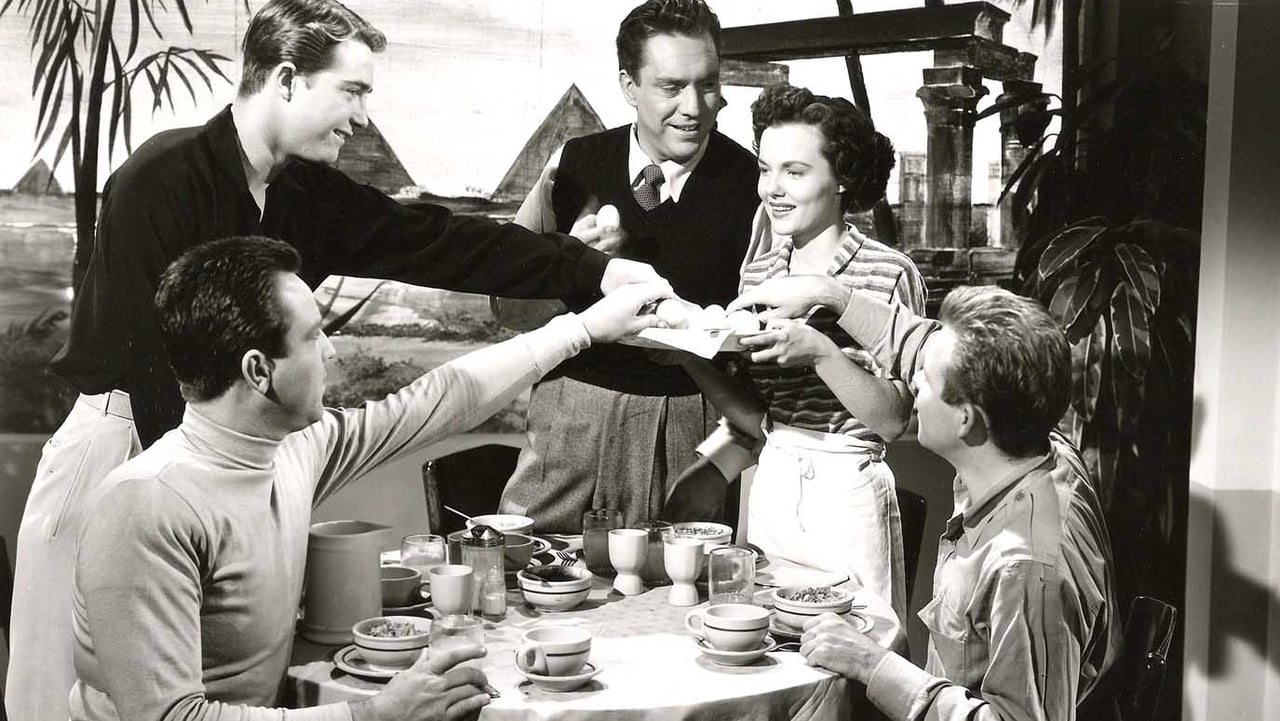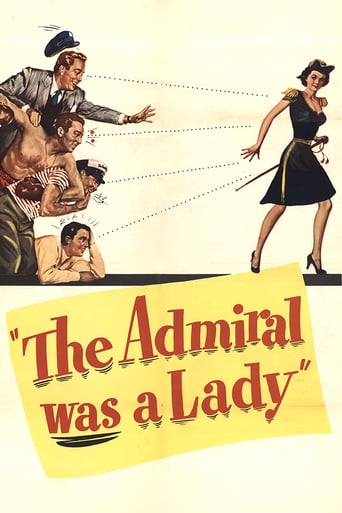

Copyright 4 August 1950 by Roxbury Productions, Inc. Released through United Artists. New York opening at the Palace: 12 October 1950. U.S. release: 4 August 1950. U.K. release: 9 April 1951. Australian release: 13 July 1951. Running times: 87 minutes (USA), 80 minutes (UK), 65 minutes (Aust).SYNOPSIS: An extremely diminutive but aggressively meddling young woman innocently tries to wreck the lives of four ex-combat servicemen.COMMENT: By independent standards this movie has good production values, including smart sets and lustrous photography, smooth direction and silky film editing. The cast is very capable too. The trouble is the script. Although it offers some promising ideas, it tends to fall between two stools: Too talky but insufficiently witty for a comedy of manners; too clumsy and insufficiently fast-paced for slapstick, though it does have a couple of frantic episodes. The most effective episode has O'Brien slowly beaten up in a prize ring in which Rogell and O'Brien successfully bring off an extremely difficult balancing act. It's funny but it's horrifying. All our sympathy is with O'Brien, but we can't help laughing at him. This sequence alone makes The Admiral Was a Lady worth watching.If O'Brien seems over-boorish in the early stages of the film, put up with him. His character develops. Unfortunately the other players are stuck with more pasteboard figures. Wanda Hendrix is doubly unfortunate. Not only is she an unsympathetic, over-talkative, meddling little fool, but she stays stupid for the whole film. Her devotion to the mysterious Henry seems ill-balanced. The other players have little to do, including Rudy Vallee. We keep waiting for him to come back, but when he does, he doesn't fulfill our expectations.OTHER VIEWS: Saddled with a script that obviously thinks it's much funnier than it actually is, The Admiral Was a Lady offers moderate entertainment at best. Rudy Vallee is wasted in a thankless role. Of course it would all be improved a good deal by cutting. I wonder what the U.K. and Australian prints are like? -- JHR writing as George Addison.
... View MoreThis movie is one of those true gems that seems to have slipped through the cracks in time. It wasn't a big hit in its day – most likely because it wasn't made or distributed by one of the major studios. It didn't have the build-up and promotion that the majors gave their films. Nor did it have a big name cast to sell it. But, "The Admiral Was a Lady" has an excellent screenplay with a wonderful story. It's main plot is supplemented with a subplot, and then another, and finally a sort of surprise subplot toward the end.The title refers to the female lead, Wanda Hendrix who gives an excellent performance of a discharged ensign WAVE, Jean Madison. But the main focus of the film is the character of Jimmy Stevens, a former Army Air Forces bomber pilot and captain, played by Edmond O'Brien. O'Brien is exceptional in this role. Had the film been made by one of the big five or six studios, I think he would have had an Academy Award nomination. The fact that this film, with its particular story, doesn't have any of the glamorous leads of Hollywood in the roles, makes it all the more real and down to earth. That is, real for the times and situations, if not the particular and peculiar circumstances of Jimmy and his crew. O'Brien was 35 when this film was made, and he would go on to win an Oscar and two Golden Globes in his career, with another Oscar nomination.The rest of the cast were all very good as well. The technical aspects and production were all very good. This is not a film with lots of laughs, and it doesn't have slapstick. Rather, it is a film with a tremendous number of humorous situations. One after another, they build on the plot and form subplots as the film progresses. Each situation or encounter adds more smiles and chuckles. It has just enough repartee between Jimmy and Jean to give added laughter. And over all of this, there is a sense of friendship and camaraderie, and kindness toward others, that gives a special glow to the film. At some point, viewers may begin to wonder what the heroin voices about this group of discharged World War II vets. "When are they going to stop being deadbeats and get back into life after the war?" Then, the little surprises of the film will start to unravel, thanks to Jean's own kindness and caring for the guys. The plot has a lot more written into it than meets the eye. If the Armed Forces had more people like Captain Jimmy Stevens, it might have saved considerably in the post-war costs to treat veterans and help them readjust to civilian life in peace time. And, it surely would have benefited countless veterans who for many years – even decades – suffered with what then was called "combat fatigue." Today we know it as PTSD (post traumatic stress disorder). It's very interesting that Wanda Hendrix had just come off a divorce from Audie Murphy. They had married in February 1949 and divorced in April 1950. It was the first marriage for both, but Murphy was suffering form PTSD from his service in WW II. He was the most decorated serviceman of the war, and performed many heroic actions at the risk of his life. But, his experiences left deep scars and he woke up screaming at night from nightmares. He had a terrible temper, slept with a loaded gun at his bedside, and carried weapons with him to the studios. His recovery was very slow. This movie has some historical value also for its depiction of the time after WWII and the programs to aid veterans adjusting back to civilian life. I don't know of any other film that has anything about the "52-20" program. That was an unemployment assistance program for war-service veterans to help tide them over until they could find work. It paid $20 per week for up to 52 weeks. The program was part of the GI Bill (The Servicemen's Readjustment Act of 1944). The GI bill included college aid, costs for technical school training, the 52-20 program and some other provisions. The American veteran population at the end of the war was 15,163,000. The 52-20 program began in September 1944, and it was extended four more years until 1949. More than 8.7 million veterans received help from the program. In its last year, only 840,000 vets had used their full entitlement, and there were 650,000 veterans still on the rolls. But 14.5 million had returned to the work force or gone on to college or technical training. Incidentally, the plane that Jimmy and his crew flew (which they called Sinful Sinthia), was a Douglas A-20 Havoc light bomber intruder. The normal crew was two or three, but Jimmy's plane had four. The U.S. made nearly 7,500 of these aircraft that served from 1939 through 1944. Besides the American Army Air Forces, the RAF and Soviet Union used many A-20s. Ohers that also flew them were France, Australia and the Netherlands. This is a movie that is sure to please most viewers. It's a warm comedy romance that includes a slice of life and history for WWII vets in the years right after the war.
... View MoreI agree with the other reviewer that this is one of the best in screwball comedies and deserves more recognition than it has gotten in the past. I came across it quite by accident when purchasing a 50 movie video collection. There were some Stooges (not too fond of), East Side Kids (ok but not attractive enough), and a few other good and unusual movies. THIS one stood out as probably one of the best in the collection for its zany twists and turns and fun all around. As another viewer said, it has an unique twist to the "returning soldier" story. I would think it would fit best under the Preston Sturges movies for the amazing wild and funny antics, Rudy Vallee with the ever persistent glasses that Sturges first placed on his nose in Palm Beach Story, and the heart that demonstrates that even the crazies of men with the craziest ideas has a definite purpose in mind and not so crazy after all.Rudy Vallee and Hillary Brooke as Peter and Shirley Pedigrew nearly steal the show with their wacky relationship, but the sweet romance that builds from the very beginning when Jimmy sees the Admiral is full of innocence and charm.This is one of those movies that you wish had even more than what has been presented to you because you don't want it to stop. You want more.This is a perfect example that there are still hidden gems out there in the Golden Age of Hollywood that are still undiscovered.
... View Morefound this gem on a free streaming video site - not likely to see it anywhere else. Really enjoyable movie set just after WWII about a woman ensign (nicknamed the admiral) who falls in with a gang of lovable losers - four ex-GIs who work diligently from dusk to dawn at finding ways to avoid work. There's a silly subplot about them trying to get her back together with her long lost fiancee, and an even sillier sub-sub plot about a rich millionaire and meddling detectives. The main point of interest is the repartee between the "admiral" and the men. Sometimes she's tough as nails, but at other points it's like Dorothy's relationship with the tin man, the lion and the scarecrow. Would really like to see a computer-enhanced remake with Humphrey Bogart as Jimmy, Marilyn Monroe as Jean and Edward Herrmann as the millionaire. Favorite line - "how can such a nice man be so useless?"
... View More